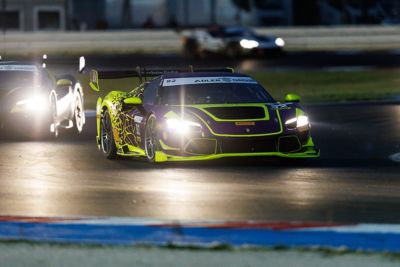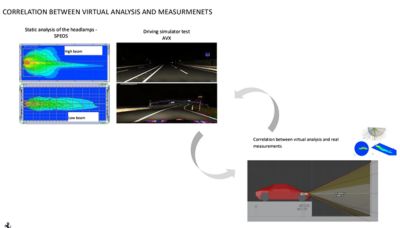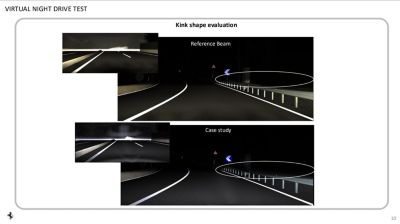Case Study
-
-
Access Free Student Software
Ansys empowers the next generation of engineers
Students get free access to world-class simulation software.
-
Connect with Ansys Now!
Design your future
Connect with Ansys to explore how simulation can power your next breakthrough.
Countries & Regions
Free Trials
Products & Services
Learn
About
Back
Products & Services
Back
Learn
Ansys empowers the next generation of engineers
Students get free access to world-class simulation software.
Back
About
Design your future
Connect with Ansys to explore how simulation can power your next breakthrough.
Free Trials
“With the help of Ansys Speos software, Ansys Zemax OpticStudio software, and Ansys AVxcelerate Headlamp software, we can design, simulate and test vehicle headlights under different night driving conditions, create and simulate various driving scenarios, perform virtual measurements, and assess glare to ensure driver safety without creating dangerous glare for other drivers.”
- Luca Dusini, Performance Trim, Innovation & Seats Development Manager, Ferrari
As the automotive industry continues to innovate, intelligent adaptive headlights represent a significant advancement in vehicle safety and driving comfort. Their ability to adapt to changing conditions makes them an essential feature for modern vehicles. They are designed to provide the best possible lighting for the situation while minimizing glare to oncoming traffic, especially when driving at night. A combination of sensors and special light designs enables them to change brightness, shape, and beam direction in response to the driving environment, improving the safety of both Ferrari road cars and race cars in different driving conditions.
Challenges
Ferrari is continuously evolving its headlamp technologies to keep pace with consumer expectations for the luxury and exclusivity that is associated with the brand. However, development and optimization of these rapidly changing optical systems is complicated by numerous performance, safety, and regulatory requirements.

Ferrari race car headlamps illuminate the track at Ferrari Challenge Europe: Misano 2025.

Correlation between actual measurements and simulations for AVxcelerate Headlamp software and Ansys Speos software.
Engineering Solutions
Ferrari relies on Ansys Speos software and Ansys Zemax OpticStudio software to design its advanced HD (high-definition) headlamp technology. Ansys Optics software enables the design and optimization of innovative headlamp systems in a virtual design space, which is crucial for rapid and cost-effective product development.
Further, from a testing perspective, Ferrari’s headlamp technology development has greatly benefited from AVxcelerate Headlamp software for night driving scenarios. Introducing Speos simulations into this controlled testing environment effectively streamlines the development of intelligent lighting systems, enabling behavior validation and potential edge case testing early in the design phase.
AVxcelerate Headlamp software supports real-time optical simulation for a variety of intelligent lighting applications, including adaptive front-lighting systems (AFS), adaptive driving beam (ADB), matrix and pixel beam. It can be interfaced with the lighting system control algorithm in dynamic driving conditions. Safety regulations or consumer ratings such as Insurance Institute for Highway Safety (IIHS) can be assessed in a virtual environment. This also enables early driver-in-the-loop testing, thereby enhancing final product quality and reducing the risk of late-stage development issues.

Virtual night drive testing in Ansys AVxcelerate Headlamp software
Benefits
- Ferrari relies on OpticStudio software to design and optimize a projection lens for a matrix LED high beam or image projections. Metrics such as image quality, relative illumination, and distortion are essential for achieving optimal performance and can be validated in the software.
- The manufacturer also uses Speos software in the design of complex system hardware and the validation of its expected performance, as well as the sensor integration needed to support safe, reliable headlamp function. without the need for the time and expense involved in building physical prototypes.
- Speos software also enables simulation of the headlamp’s light distribution using a proprietary format named XMP, which includes the spectrum of light to simulate chromatic aberrations caused by the projector lens at the low beam cutoff area. This light distribution simulation can then be experienced in dynamic driving conditions with AVxcelerate Headlamp software.
- The data transfer between OpticStudio software and Speos software necessary to optimization can easily be accomplished using the ODX (Optical Design Exchange) format or CAD data. These formats allow for seamless integration and exchange of design data, enhancing efficiency during the design phase.
- These optical capabilities extend to the building of matrix beam and pixel beam intelligent lighting systems which can then be tested in AVxcelerate Headlamp software in a virtual driving environment to ensure lighting system performance.
- Traditional techniques for testing rely on night drive sessions. Those are costly, involve nighttime driving, and are sensitive to weather conditions. Replacing this activity with virtual testing in AVxcelerate Headlamp software saves a lot of time and costs.
- Leveraging AVxcelerate Headlamp software, Ferrari engineers can simulate and test vehicle headlamps during night driving conditions by testing system behavior subject to numerous test cases. With this, they can identify and understand the impact of chromatic aberrations on the perceived quality, headlamp optical performance, and control software on the balance between driver visibility and other drivers’ glaring.
- Any optical issue identified in AVxcelerate Headlamp software can be reworked in Speos software, then validated against industry-certified light simulation tools, ensuring trustable reviews of lighting system performance before entering the physical prototyping phase to reduce both time and cost.
- This activity is crucial for ensuring that the headlamps provide optimal visibility and safety during night driving according to strict industry standards. It enables Ferrari to accurately test performance in a virtual night scenario from the driver’s actual point of view, resulting in confident system optimization and validation.

Simulation results showing the low beam cutoff, the illuminance at the level of the road (bird's-eye view), and light leakages.
Let’s Get Started
If you're facing engineering challenges, our team is here to assist. With a wealth of experience and a commitment to innovation, we invite you to reach out to us. Let's collaborate to turn your engineering obstacles into opportunities for growth and success. Contact us today to start the conversation.